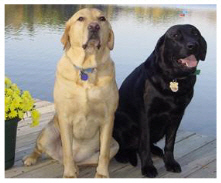Be Persistent When Training Your Dog to Come On Command
Most Dogs aren't actually insubordinate or stubborn. Many times, however, they may seem to be at first because they don't understand precisely what they're supposed to do. To make this clear, you need to seize the alpha leadership status very quickly and show that you expect obedience. Be ready to use patience and determination and firm instruction to establish the behavior wanted. This can sometimes be hard to do when teaching the command "come".
It's in their nature for dogs to scout out their surroundings. They will smell anything and everything, dig up, turn things over, and pick up little objects. When doing a teaching session curtail any distractions by trying to be as far away from other people and voices as possible. It's a good idea to use a backyard that is clear of obstacles or a room without small objects on the floor.
Be sure to take full advantage of any instinctive behavior you see. For instance when you observe the dog coming toward you, execute a vocal command along with a hand sign to support this behavior. Try to use a command and sign that you don't normally use during your other teaching sessions.
To begin, stand in front of the dog and put it in the sit position. Execute the "stay" command as you move back several steps. Use the vocal and hand sign command. Give the dog bountiful praise for correct behavior, but don't give praise for partial or incorrect responses.
Repeat this as you continue stepping back several more steps. If the dog comes to you prematurely, give the "sit-stay" command and try it again. If the dog doesn't want to come at all you may have to use a toy or a snack to prompt him a little bit.
For dogs that are sluggish learners, or a little reluctant, leash and collar training may be required. Put your dog in the sit/stay position and begin to back up a few feet as you are letting out some excess on the leash. If your dog resists, give a gentle tug that is pronounced enough to get the message across while giving the vocal command along with the hand sign.
For a dog that comes too soon, use a long rope or leash and wrap it around a stake or a tree. If the dog starts to respond too early pull the leash as you execute the "stay" command. If there are no trees around, use someone to help with the session. The negative part about using someone else during the session is the dog can become puzzled about who they should focus on. It's usually best if they just focus on one person.
While instructing, consistency and patience is critical. Dogs don't as a matter of course understand the usefulness of 'come' or any other human-induced behavior. Screaming when the dog messes up or is a little reluctant is normally detrimental. Put in place your alpha position with tone of voice, body posture and willingness to wait for compliance. Physical punishment or abuse is not a helpful method.
Many dogs immediately prove themselves to be happy to please and are very responsive to praise following the learned behavior. Just be certain they're the ones 'coming', not you. If need be, prove that you're the demanding one when it comes to their behavior.


